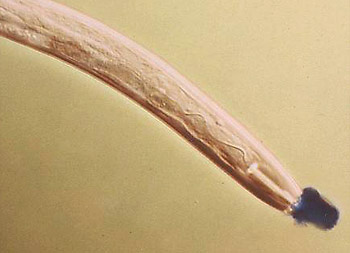Contributed by Gustavo A. Fermin-Muñoz
Fermin-Munoz, G.A. 2000. Plantbodies: An animal strategy imported to the plant kingdom to fight back pathogens. APSnet Features. Online. doi: 10.1094/APSnetFeatures-2000-0500D
One of the most remarkable aspects of recombinant DNA technology is when a protein belonging to the exclusive realm of animals can be successfully used in plants to help them fight against pathogens that are difficult to control. The expression of viral- or nematode-specific antibodies in planta and hence, the term plantibody, (Gibbs 1997, Smith 1996) is a promising new avenue for controlling plant pathogens (Schots et al. 1992). This unconventional method of pathogen control relies on cloning the variable parts of the light (VL) and the (VH) heavy chains of an antibody molecule linked to a carrier peptide; the expression of the plantibodies in the transgenic plant can lead to their accumulation in the plant cell cytosol. These plantibodies will specifically interact with the intended target inactivating its biological function (Zhang and Wu 1998). So far, two clever strategies have been devised against two important plant pathogens: Tomato Spotted Wilt Virus (TSWV) (Franconi et al. 1999) and root-knot nematodes Meloidogyne spp. (Baum et al. 1996).
In the case of TSWV, the production of secretory monoclonal antibodies from the corresponding cloned mammalian gene will allow the engineered plant to inactivate the N, G1/G2 and NSm proteins of the virus. TSWV is a destructive pathogen of tomato crops and no reliable method of control is available. In the case of root-knot nematodes a cellulase from M. incognita, and other Meloidogyne species, in addition to other stylet secreted proteins (Figure 5.1), have been selected as targets for this strategy (Baum et al. 1996). The plant parasitic nematode’s cellulases are important in the initial steps of pathogenesis. The rationale of selecting cellulases as the target of plantibodies is that upon contact between the anti-cellulase plantibody and the nematode cellulase, the migration of the nematode inside the plant will be stopped or diminished. If successful, this strategy will allow farmers to avoid using highly toxic nematicides, soil sterilants or fumigants. Other useful targets under analysis are the proteins involved in the initiation of the cell cycle that leads to the generation of giant cells that support the feeding nematodes in infected roots (Vrain 1999).
|

|
|
Figure 5.1 Stained stylet proteins generated by an infective
juvenile (J2) of the potato cyst nematode Globodera rostochiensis.
Photo courtesy Wageningen Laboratory of Nematology. |
These two examples of plantibodies are under study and development, but practical applications are still far from reaching the field until a more complete picture of the molecular interactions involved in these pathosystems emerges.
References
Baum, T.J., Hiatt, A, Parrott, W.A., Pratt, L.H., Hussey R.S. 1996. Expression in tobacco of a functional monoclonal antibody specific to stylet secretions of the root-knot nematode. Mol. Plant Microbe. In., 9:382-387.
Franconi, A., Roggero, P., Pirazzi, P., Arias, F.J., Desiderio, A., Bitti, O., Pashkoulov, D., Mattei, B., Bracci, L., Masenga, V., Milne, R.G., Benvenuto, E. 1999. Functional expression in bacteria and plants of an scFv antibody fragment against tospoviruses. Immunotechnology, 4:189-201.
Gibbs, W.W. 1997. Biotechnology – Plantibodies. Sci. Am., 277: 44.
Schots, A., deBoer, J., Schouten, A., Roosien, J., Zilverentant, J.F., Pomp, H., Bouwmansmits, L., Overmars, H., Gommers, F.J., Visser, B., Stiekema, W.J., Bakker, J. 1992. Plantibodies- a flexible approach to design resistance against pathogens. Neth. J. Plant Pathol., 9:39-46.
Smith, M.D. 1996. Antibody production in plants. Biotechnol Adv., 14:267-281.
Vrain, T.C. 1999. Engineering natural and synthetic resistance for nematode management. J. Nematol. 31:424-436.
Zhang, Z.H., Wu, L.P. 1998. Research and development of expressing antibodies in plants. Prog. Biochem. Biophys., 25:136-139.
RETURN TO APSnet FEATURE STORY
